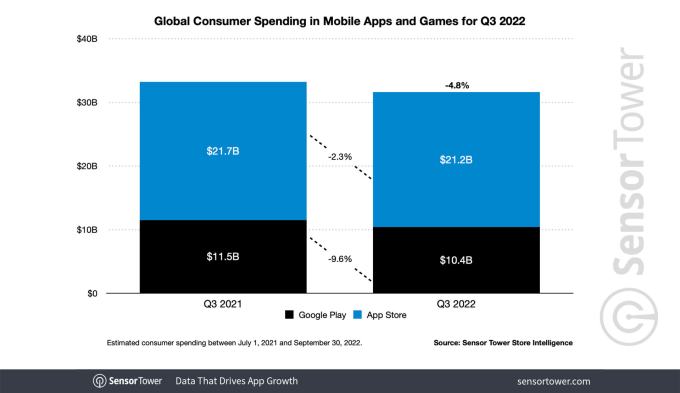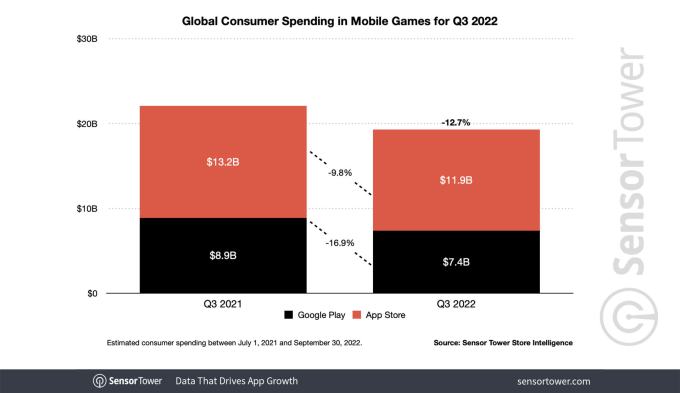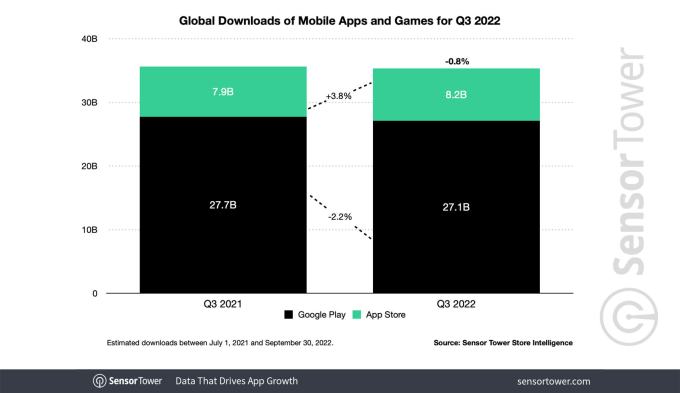Consumers reduced their mobile app spending in the third quarter of 2022 by roughly 5%, but the social video app TikTok just delivered another record-breaking quarter on this front. For the fourth straight quarter in a row, TikTok continued its streak as the app that has ever generated the most revenue in a quarter.
These new findings, in a report published today by Sensor Tower, see TikTok again becoming the highest-grossing app in the world even as the overall market is seeing a slight decline. However, the report does combine TikTok revenue with its Chinese version, known as Douyin — so it’s technically the revenue generated by the two apps offering the same feature set of short-form, vertical videos — not one.
TikTok’s global app along with Douyin on iOS together retained the position as the top-grossing non-game app across the App Store and Google Play combined, with approximately $914.4 million in consumer spending in the quarter.
Reached for comment, Sensor Tower explained that Douyin alone had generated approximately $433.5 million in consumer spending, or about 47% of that total.
On the App Store, TikTok was the No. 1 top-grossing non-game app, while it was No. 2 on Google Play, behind Google’s own storage subscription service, Google One, which had generated just over $330 million in the quarter.
To date, TikTok and Douyin’s apps have generated around $6.3 billion in total revenue, the report notes.
Across the broader app market, the trends weren’t quite as positive.
Consumer spending across in-app purchases, subscriptions and paid app downloads on both the App Store and Google Play dropped by 4.8% year-over-year to $31.6 billion in Q3, while app downloads fell a slight 1% to 35.3 billion.

Image Credits: Sensor Tower
The App Store continues to contribute to the vast majority of consumer spending, at more than double that of Google Play. In Q3, Apple’s App Store pulled in $21.2 billion, which was down 2.3% year-over-year from the $21.7 billion seen in the year-ago quarter. Google Play’s decline was even sharper, down $9.6% year-over-year from $11.5 billion to now $10.4 billion.
In the games segment, specifically, consumer spending fell 12.7% year-over-year to $19.3 billion. On the App Store, game spending was down 9.8% year-over-year to $11.9 billion while Google Play revenue was down 16.9% to $7.4 billion.

Image Credits: Sensor Tower
Meanwhile, app installs only dropped slightly. But as Google Play is responsible for driving downloads, the nearly 1% decline in terms of app installs was largely due to its 2.2% drop to 27 billion downloads in the quarter. The App Store had actually saw app installs grow by 3.8% to 8.2 billion, but this couldn’t cancel out Google Play’s larger decline.

Image Credits: Sensor Tower
TikTok was again the most downloaded non-game app with 196.5 million installs across both app stores combined and on iOS. But when Google Play is examined alone, Facebook moved into the No. 1 spot with 150.3 million installs, replacing Instagram.
TikTok breaks records as top grossing app in Q3, as overall app store revenue declines by Sarah Perez originally published on TechCrunch
from TechCrunch https://ift.tt/Gg9xbsp

Comments
Post a Comment